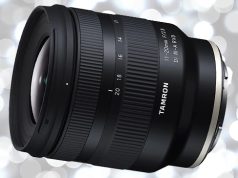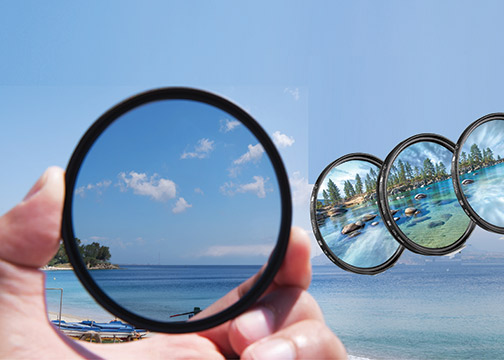
Creative modes and filter software are great, but they don’t stack up to optical filters.
Nowadays, to tweak their images, most photographers from casual shooters to pros rely on digital filter software like DxO PhotoLab or Adobe Photoshop Lightroom instead of optical glass filters. Filter software, and there are scores of programs, achieves a staggering variety of visual effects in postproduction. Indeed, all such applications are impressive in terms of range, cost and flexibility. However, traditional optical glass filters that screw into or snap in over a camera’s lens belong in every serious shooter’s camera bag.
Optical glass filters allow photographers to do a number of crucial things that can’t be accomplished in any other way. Moreover, like interchangeable lenses, they enable photographers to achieve a wide scope of effects simply, predictably, easily and at the moment of exposure when they’re actively engaged in the creative process.
What You See Is What Your Get
Furthermore, optical filters operate on exactly the same principle that defines DSLR, mirrorless and most point-and-shoot cameras; what you see is what you get. That is as long as the AWB Rule is followed: the camera’s color balance should always be set to the prevailing lighting condition, such as daylight, not AWB, which causes the camera to correct for the filter—obviously not what is wanted.

When a filter is mounted over the lens, photographers can observe its effect directly in real time on the LCD or in the EVF before pressing the shutter release. Subsequently, when they capture the precise effect they intended, it’s an integral part of the original image file—not a layer added in Photoshop or a plug-in filter effect applied in postproduction.
Without a doubt, countless outstanding images were created and brilliantly enhanced with filter software on a computer. However, there’s something to be said for creating the final image in-camera at the moment of exposure. It’s a time-honored technique that’s yielded many of the world’s greatest and most memorable images. Optical filters let photographers do just that; that’s why many of the most creative digital and analog photographers use them.
Old Optical Filters for Digital Imaging? Why Not!
The CMOS or CCD image sensor in a digital camera responds to light—and to filters—in much the same way as film. Therefore, any filters your customers may have used back in the day with color film will provide virtually the same effects in digital capture.
These include polarizing filters; soft-focus and special effects filters; UV protective filters; color-enhancing filters; graduated filters; as well as warming and cooling filters that provide a warmer (redder) or cooler (bluer) color rendition.
However, color conversion and color-compensating filters for shooting daylight-balanced slide film under indoor household illumination or vice versa are of more limited value with digital capture.
Which filters are essential for digital shooters?
Polarizer Filters: Eliminate Reflections; Make Colors Pop
One optical filter that definitely belongs in every digital shooter’s kit is a polarizer. A circular polarizer is preferable to a linear polarizer because it won’t adversely affect the metering or autofocus performance of cameras that incorporate beam-splitters in the optical path; this is a huge category that includes virtually every DSLR in current production.

What’s more, polarizing filters should be at the top of every photographer’s must-have list because they have so many practical uses and unique capabilities. A polarizer is a two-piece, variable-control filter that works by selectively transmitting or blocking light waves depending on their direction of vibration.
By turning its front ring and observing the effect in a camera’s viewfinder (or on the LCD), photographers can eliminate or minimize reflections on many shiny surfaces, such as water or glass (but not metal or mirrors). As a result, shooters can see any details (such as the contents of a store window display) that were obscured by reflections or glare.
Note: No plug-in software filter can provide true polarization that will eliminate glare and reveal obscured details. Polarizers also let users increase overall color saturation for a more vibrant color palette. And they increase the contrast of clouds to make them stand out against a deep blue sky. Both are extremely useful abilities when shooting landscapes and outdoor scenes.
Protective UV Filters: First Line of Defense
It makes a lot of sense to protect a camera lens that may cost $500 to $2,000 and up with a simple device that’s readily obtainable for a lot less. That’s probably why so many savvy shooters mount a clear glass or UV filter to protect their pricey lenses against dust, moisture, fingerprints (which can etch glass if not removed promptly!) and other physical damage.
In addition, photographers can keep the filter on a camera at all times because it has virtually no effect in ordinary picture taking. However, as the UV designation implies, the filter will absorb ultraviolet radiation that’s invisible to the eye. UV may show up as a slight bluish tinge in images taken at high altitudes or over water with film or digital cameras. Moreover, these filters have no significant effect on the exposure, and they’re generally available in wide-angle versions.
Graduated ND Filters: Selective Contrast Control
Graduated optical filters are typically half clear and half tinted. The area in between provides a graduated density transition (feathered edge), so the effect blends smoothly and the captured scene looks natural.
Using a graduated neutral density (ND) filter is an excellent way to reduce the actual brightness ratio of a scene with an excessive brightness range or contrast; in other words, a scene where the image sensor can’t capture both the brightest and darkest areas in a single exposure.
By rotating the graduated ND filter to position its darkest part over the brightest areas of the scene (usually the sky), with the clear area coinciding with the shadow areas (typically the foreground), you get a good overall exposure that looks quite natural without resorting to HD settings or image stacking.
In addition, colored graduated filters can transform the average sunrise or sunset into something spectacular without significantly affecting other colors.
Neutral Density Filters: Sometimes Less Really Is More!
Why would you want less light to reach your image sensor? Even when shooting at ISO 100 (the lower limit with many digital cameras), the ambient light level may still be too high to take pictures at a wide aperture (even at the fastest shutter speed) and create the shallow depth of field needed for de-emphasizing a distracting background or making a portrait subject pop off a soft background.
Also, photographers might want to shoot at a slow shutter speed to emphasize the feeling of motion, such as when photographing a waterfall. An ND filter will do either and sometimes both. Moreover, it will not affect the color balance or color accuracy of the image.
Special Effects Filters: Instant Hollywood FX
The range of special effects possible with optical glass filters is virtually limitless. In fact, their ability to add a precise, repeatable, predetermined effect while taking the picture by simply screwing or snapping a filter over the lens is a liberating experience for any creative photographer.
Unfortunately, we can’t detail every type of special effects filter in this limited space; however, even the short list is mind-boggling. It includes linear, curvilinear and random patterns; a profusion of starburst and prismatic effects; an extensive range of levels and types of diffusion; mist and fog; as well as myriad unique and spectacular color effects.
By all means, check out the extensive online catalogs of the major filter manufacturers to get a comprehensive picture of what’s available. In the meantime, please peruse our concise selection of traditional optical filters.
Eight Quintessential Optical Glass Filters for Digital Shooters
Tiffen Digital HT Color-Grad ND 0.6
This upgraded classic image-control filter from Tiffen lets users reduce the exposure by 2 stops in selected areas of the frame; for instance, when capturing an expanse of sky or beach. Moreover, the neutral density filter provides a feathered edge between the density and clear areas to create a natural-looking taper. Also, neutral density filters do not affect the overall coloration of the image.
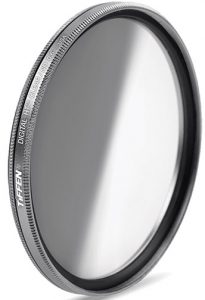
Upgrades to this filter include a low-profile titanium filter ring and Tiffen’s high-transmission Digital HT Multi-Coating. Furthermore, all Tiffen ND filters are manufactured using the proprietary ColorCore process to ensure uniformity. Tiffen Digital HT Color-Grad ND 0.6 filters come in sizes from 52mm to 82mm, $65–$156.
Cokin P Creative Graduated ND Kit
This Cokin kit consists of three graduated ND filters: a 1-stop (0.3) hard-edge; a 2-stop (0.6) hard-edge; and a 3-stop (0.9) soft-edge filter. Photographers may use the filters individually or in any combination. Furthermore, the kit is designed to prevent overexposure in specific image areas, such as bright skies. It also yields natural-looking, even-toned landscape and scenic images.
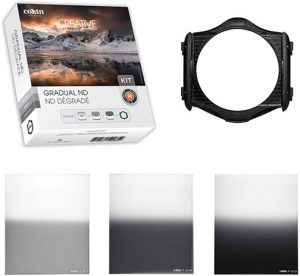
The filters are made of durable optical resin. What’s more, each ND filter measures 84x100mm to cover a wide variety of lenses. The hard-edged filters are useful for images with clearly defined horizon lines. The soft-edged filter is more effective where the transition between sky and foreground is less distinct; for example, in images that include mist, fog or treetops. The kit also includes a microfiber cleaning cloth and a Cokin P-series filter holder that accepts rectangular Cokin P and other filters measuring 84mm wide and 1.6mm thick. However, it doesn’t include a required Cokin P adapter ring. $60.
Lee Filters 105mm Landscape CP
Made by an acclaimed producer of professional filters, this outstanding circular polarizer reduces reflections on glass and water; minimizes glare; and also enhances overall color saturation in skies. Moreover, the filter imparts a touch of warmth to bring out green, brown and gold earth tones to enhance landscapes and images with foliage.

Constructed of top-quality optical glass, it’s compatible with the Lee 100mm system via an optional 105mm accessory ring. In addition, the filter’s slimline profile reduces the likelihood of vignetting when it’s used with ultrawide-angle lenses. However, as a result, it has no front threads for filter stacking. Like all circular polarizers, it also has no effect on the camera’s autoexposure or autofocus functions. $245.
Hoya Black Mist
Hoya, Japan’s largest filter manufacturer, created this filter for photographers who want to achieve a subtle overall softening effect and moderate harsh contrasts. They offer both a white mist filter and a black mist diffuser filter.
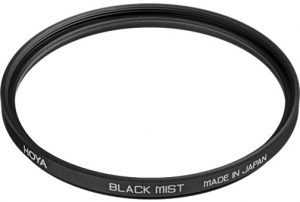
The Black Mist is especially useful in portraiture where it can smooth out wrinkles and skin blemishes to yield a more flattering likeness while still retaining good overall detail. Further, it creates a soft-glow effect by reducing contrast areas between highlights and shadows. The filter is constructed of high-grade optical glass that’s set in an aluminum ring. It also has a threaded front ring for stacking additional filters or adding a lens cap. 49mm to 82mm, $33.99–$79.99.
Sigma WR Ceramic Protector
We often include this one in filter articles because, well, it’s a great choice. Many experienced shooters use a clear or UV filter over their lenses to protect their precious glass from dust, sand, scratches as well as direct physical impact. However, the Sigma WR Ceramic Protector filter takes this protection to a considerably higher level. It employs a super-hard ceramic substrate that combines an impressive 99.7% transmittance value, a hardness greater than chemically strengthened glass, and flexibility greater than sapphire crystal.
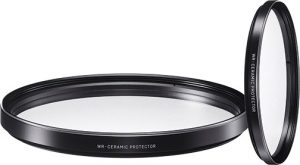
Consequently, this filter delivers superior shock, scratch and impact resistance under adverse conditions. It also features a water-repellent antistatic coating that resists water droplets and smudging. 67mm to 105mm, $93–$315.
ProMaster HGX Prime Variable ND
These high-quality ProMaster VND filters provide an extremely wide light reduction range of 1.3 to 8.8 stops (ND 3–ND 400!). This allows photographers to shoot at a wider aperture and/or a slower shutter speed to achieve selective focus effects or more natural-looking motion effects.
The filters feature advanced antireflection (AR) multicoating to minimize reflections off digital camera sensors. They also employ exclusive Repellamax II antistatic coating to repel moisture and facilitate cleaning.
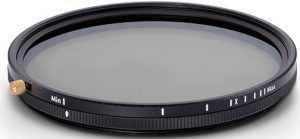
ProMaster uses ultra-hard, scratch-resistant optical glass to resist surface scratching and other abrasion. In addition, they are fitted in an ultrathin low-profile frame to prevent vignetting with ultrawide-angle lenses. The outer rim of the glass is treated with a special black ink, and the metal frame has a satin finish—both minimize reflections. Each filter has a removable, knurled knob that allows for fast
Schneider True-Streak Confetti
Created by Schneider, the renowned German lens company, this unique special effects filter adds a new level of creative expression to images. It incorporates the full array of True-Streak colors scattered randomly throughout its optical surface. The striking result is a random pattern of multicolored bursts and streaks of varying lengths, thicknesses as well as positions. Moreover, they seem to emanate from any light point or highlight in the subject.
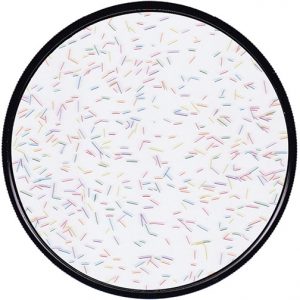
The screw-in filter features high-grade optical glass. What’s more, thanks to the randomized pattern, no two filters are alike. The company says the filter is perfect for music videos and concert footage, but we know creative content creators will find a multitude of applications for this fun filter. 77mm, $160.
Tokina Hydrophilic Protector
This clear filter from Tokina not only protects the lens from physical impact but also completely prevents water from beading on its surface when shooting stills or videos in wet conditions. Its front hydrophilic protective coating repels moisture evenly but adds no additional color or contrast to the image. Water spreads into a film over the glass rather than forming droplets.
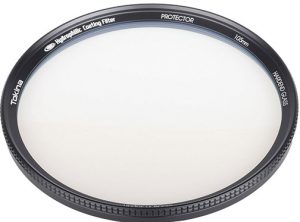
In addition, a photocatalyst layer between the hydrophilic coating and the underlying glass permits the full functionality of the hydrophilic coating to be restored after exposure to copious amounts of water; simply expose the front of the filter to UV or sunlight for eight hours under dry conditions.
The self-cleaning filter consists of ultra-clear transparency optical glass for enhanced durability, clarity and color fidelity. Tokina chemically enhanced the harden glass to make it 4x stronger than normal optical glass. The filter also has an ultrathin ring to minimize vignetting with ultrawide-angle lenses. 77mm to 127mm, $199–$229.



